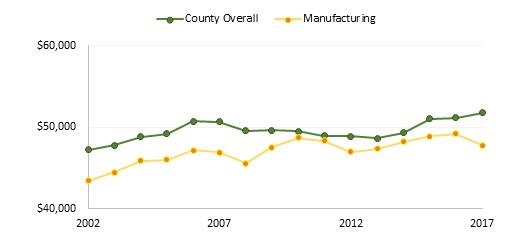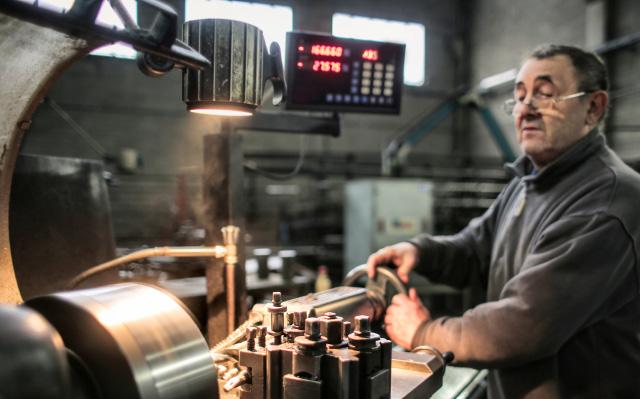
8 minute read
The Current State of Manufacturing in Miami-Dade County and South Florida
Make it Miami
The manufacturing sector typically has been considered one of the most important sectors in the United States, providing stable jobs with earnings above the average overall per capita earnings. Manufacturing jobs in the United States have declined considerably over the past several decades, peaking in 1979 at 19.4 million. In less than a decade, by 1987 manufacturing jobs decreased to 17.6 million. From nearly a third (32.1%) of the country’s total employment in 1953, manufacturing employment has fallen to about 12% today. Today, the manufacturing sector is the fifth largest employer, after health care and social assistance, retail trade, accommodation and food services, and administrative, support, waste management and remediation services. 6
Advertisement

The decline in manufacturing jobs is the product of various dynamics, most dominant of which are offshoring and automation. While offshoring has played a significant role, it is important to note that the U.S. manufacturing output, which is the value of goods and products manufactured in the U.S., has grown strongly. Manufacturing has historically experienced rapidly rising productivity growth and declining employment. The debate on the reasons for the decline of employment in the sector continues, with one camp blaming foreign competition, and the other side pointing to the role of automation as a job-killer.
However, the manufacturing sector has a very low unemployment rate, possibly related to the high demand for workers with specialized skills in the industry. In 2017, the unemployment rate for manufacturing workers was 3.3%, the lowest since 2000. The highest unemployment rate was in 2009 -11.9%. Preliminary data for October 2018 shows 522,000 job openings in the sector, the highest of any month over the last two decades (U.S. Bureau of Labor Statistics).
The business and employment trends of the manufacturing sector in Miami-Dade mirror some of the national trends in both number of establishments and workforce. Table 1 shows that nationally, the number of manufacturing firms and employment in the sector decreased over the last 15 years. While the recession decline affected all sectors, the manufacturing decline had started prior to 2007. From 2002 to 2006, the number of U.S. establishments decreased by 6.2% continuing the trend from the 1980s and 1990s (U.S. Bureau of Labor Statistics). In the last two decades, the smallest number of manufacturing establishments in the U.S. economy was in 2012-2013 when there were 335,000 firms in the sector. Similarly, in Miami-Dade, the sector had been in decline for decades. It shrank in the recession but recovered in 2017, when there were a total of 2,847 establishments. Manufacturing in Miami has undergone a quiet revival as the number of firms in 2017 is only slightly below the high of 2,932 in the last 15 years. While the number of firms grows, the total number of employees in them has shrunk.
Table 1: U.S. Manufacturing Prifile, 2002-2017 Table 2: Miami-Dade Manufacturing Prifile, 2002-2017
Year
Firms
Total Employment Avg. Wages
2002 383,863 15,209,192 $44,097
Year
Firms
Total Employment Avg. Wages
2002 2,932 55,083 $31,878
2007 361,419 13,833,022 $53,489
2012 334,800 11,904,945 $60,496 2007 2,591 46,742 $39,716
2012 2,636 35,738 $44,006
2017 346,723 12,406,757 $66,840 2017 2,847 40,893 $47,815 Source: Quarterly Census of Employment and Wages (QCEW), U.S. Bureau of Labor Statistics.
Another notable fact is the growth of the sector in the last five years. From 2012 to 2017, the number of manufacturing firms increased by 3.6% and the sector’s workforce grew by 4.2%. In fact, the MiamiMiami Beach-Kendall metro area placed fourth among the 71 largest metros (those with more than 450,000 nonfarm jobs) with 22.6% growth in industrial jobs, while West Palm Beach-Boca Raton-Delray Beach placed fifth with 27.3% job growth since 2012.
The creation of new manufacturing jobs has not been accompanied by a significant upward push in wages. Manufacturing wages in Miami-Dade continue to lag behind the wages of workers in the United States overall. In fact, the gap has increased. Manufacturing workers were paid 35% less in 2007 and 40% less in 2017, in comparison to national wage levels for the sector.
One possible explanation for the lower manufacturing wages overall is the underrepresentation of manufacturing establishments in the advanced industries sector. The advanced industries distinction was developed by the Brookings Institution after the 2008 recession, as a tool to explain the role of specific industries that inordinately drive regional and national prosperity. Beginning with the 2015 report “America’s Advanced Industries: What They Are, Where They Are, and Why They Matter,” Brookings formally defined and began to track the growth of the sector. Despite the decline of the sector in terms of overall employment, it remains a vital source of innovation and competitiveness, making outsized contributions to research and development, exports, and productivity growth. Within the sector, there are 35 manufacturing industries — aerospace, automotive, and medical devices among them – which rely on high-value innovation and technology.
The most recent data reported by manufacturing sector establishments in Miami-Dade is from the second quarter of 2018, provided by the Florida Department of Economic Opportunity. It shows that the manufacturing sector in Miami is primarily comprised of establishments that fall in the light industry category, meaning that they produce small goods that will be sold to household consumers rather than to another manufacturer (Figures 1- 2). Of the 2,847 manufacturing establishments reported by the Florida Department of Economic Opportunity, only 927 are classified in the advanced industry sector. The average wage in these establishments is $57,275,

Figure 1: Top 10 Manufacturing Industries in Miami-Dade County by Number of Establishments MIAMI MANUFACTURING REPORT
10.6% higher than the average wage of $51,806 in the county. The manufacturing firms in the advanced industry sector employ over 13,000 workers, approximately one-third of the manufacturing workforce. As already noted, the average manufacturing firm size in the sector in Miami-Dade is 14. Of the top three sub-sectors with large employment, architectural and structural metals manufacturing firms have average employment of 22. Firms in the printing and related support activities subsector have 9 employees on average. Bakeries and tortilla manufacturing firms average 13 employees. The median manufacturing firm size overall in Miami-Dade is 12 employees.
Figure 2: Top 10 Manufacturing Industries in Miami-Dade County by Number of Employees
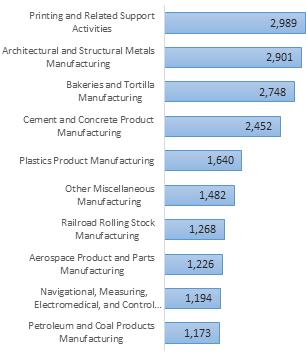
Source: Quarterly Census of Employment and Wages (QCEW), U.S. Bureau of Labor Statistics.
Trend data from the U.S. Bureau of Labor Statistics shows that over the last 10 years, the number of manufacturing firms in Miami-Dade increased by 9.9%, which was lower than the 13.1% increase of firms in the county overall. Figures 3 and 4 show that the recovery of the manufacturing sector lagged. The number of businesses in the county began increasing in 2010, while in manufacturing the first increase was in 2011. However, the number of manufacturing firms still has not reached its 2002 level of 2,932.
Figure 3: Number of Business Establishments in Miami-Dade County, 2002-2017
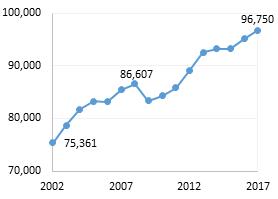
Figure 4: Number of Manufacturing Establishments in Miami-Dade County, 2002-2017
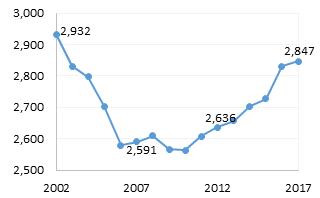
The increase of the workforce employed in private firms in Miami-Dade mirrored the increase in establishments. From 2007 to 2017, there was a 13.9% increase of private employment overall. However, employment in the manufacturing sector declined in that period. Figure 6 shows that a gradual increase of employment in the sector commenced in 2011. but the 2017 employment levels are well below the over 55,000 employees reported in 2002.
Figure 5: Number of Private Establishment Employees in Miami-Dade Businesses, 2002-2017
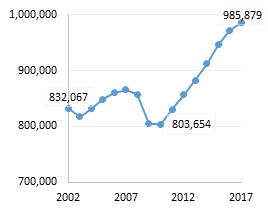
Figure 6: Number of Employees in Manufacturing Businesses in Miami-Dade, 2002-2017

The manufacturing sector is not performing as well as the overall economy in terms of wages. Total wages for all private workers in Miami-Dade (adjusted for inflation) increased by 16.4% since 2007. Total wages paid increased from an estimated $44 billion to $50 billion in 2017, however declined by 12% in the manufacturing sector with total wages paid decreasing from an estimate of $561 million to $493 million in 2017. The decline is even more significant since 2002 – 17%. As shown in Figure 7, Manufacturing wages represent only 1% of total wages paid by private employers in the county.
Figure 7: Aggregate Manufacturing Wages, 2002-2017

When adjusted for inflation, average wages for workers in all sectors increased only nominally, by 2.2% since 2007 for the county overall, and 1.8% in the manufacturing sector. Despite the upward trend, the average wages in the manufacturing sector trailed wages overall in the county (Bureau of Labor Statistics, Figure 8). In fact, while wages in the county overall continued to increase, there was a 2.8% decrease in average manufacturing sector wages from 2016 to 2017. Averages are affected by very high and very low wage earners who can skew the figure in a particular direction. Median earnings are not available from the Bureau of Labor Statistics but the most recent U.S. Census estimates for 2017 show that the earnings for full-time employees in the manufacturing sector was $36,201, 2.2% higher than the overall earnings in the county of $35,416. The higher median earnings in manufacturing indicate a higher proportion of better paid jobs in that sector.
Figure 8: Average Annual Wages in Miami-Dade Overall and for Manufacturing Businesses 2002-2017
